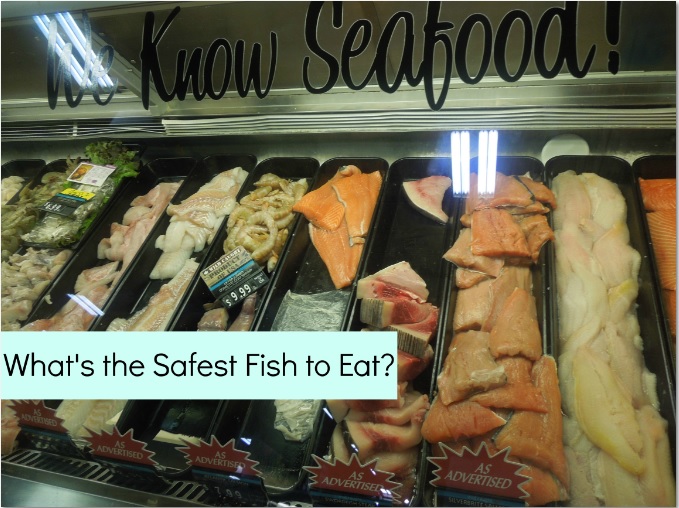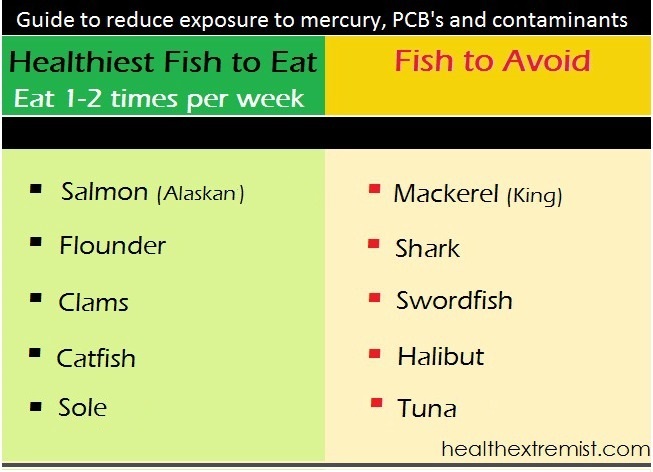This post may contain affiliate links. Please read my disclosure.
Why it’s Good to Eat Fish
Fish is a healthy choice, yet many avoid this excellent source of nutrition due to concerns of mercury, PCB’s and other contaminants.
For this reason, I also avoided fish for a while. Whenever I walked into the food store and went to the fish counter, I often forgot which fish was safest.
Even though some types of fish should be avoided due to the mercury and level of toxins (heavy metals, industrial waste products etc.), there still is a good variety of fish that are not only safe to eat, but have great health benefits unlike any other food.
Fish is the best source of omega-3 fatty acids and also supplies vitamins and minerals. Those with diets consisting of fish at least twice a week have been shown to benefit from improved immune system function, improved vision, decreased risk of heart disease, and improved brain development in infants. One study found those that consumed fish had a 36% reduced risk of death from coronary heart disease.
Important to Select the Right Kind of Fish
When it comes to eating fish, the most important part is selecting the right type of fish. All fish contain some amounts of mercury, chemicals, dioxins, PCB’s and other contaminants, but it’s most important to avoid those with the highest amounts.
Having good gut flora (beneficial bacteria) also helps reduce the negative effects of mercury because they bind with the mercury and prevent absorption.
There are quite a few varieties that contain the least amount of chemicals and mercury and are safe to eat in moderation; thus, the benefits outweigh the risks. Those listed below as “fish to avoid” should be completely avoided due to the high number of toxins.
Healthiest Fish to Eat:
Don’t Buy Farmed Seafood!
Following the chart above is an easy way to select the healthiest fish to eat, but you also have to check where the fish comes from!
The majority of fish, over 80% comes from developing countries such as Thailand and Vietnam, where regulations are not as strict. In these countries the fish may be raised in unsafe conditions such as waste. Pesticides, banned chemicals, and heavy metals are also even more of a concern for fish not raised in the USA. When the fish is raised in unsanitary conditions, they add even more pesticides and antibiotics.
When it comes to selecting fish, do NOT buy any FARMED fish! This is a great concern especially when selecting which type of salmon to get. You want to get wild caught salmon that is labeled as Alaskan salmon. If it is not labeled as Alaskan salmon, this means it is farmed or Atlantic salmon, neither of which you want because it is the most harmful to health!
Salmon:
*Safe-Alaskan –also labeled as: King Chinook Salmon, Silver Coho Salmon, Red Sockeye Salmon
*Not safe- farmed/Atlantic
If you have trouble finding the Alaskan salmon fresh, you can also buy it frozen. I usually get mine frozen because my local health food store rarely has any fresh available.
How Often Should You Eat Fish?
Most recommend consuming fish in moderation, about 1 to 2 times per week. This reduces your exposure to the chemicals and mercury in fish.
Sources:
http://www.marksdailyapple.com/better-fish-choices/#axzz2ZcFa5yX9
http://www.naturalnews.com/032225_fish_nutrients.html



UNFORTUNATELY, ALL THIS INFORMATION IS NO LONGER UP-TO-DATE IN LIGHT OF WHAT FUKUSHIMA TEPCO NUCLEAR POWERPLANT HAS DONE TO THE PACIFIC OCEAN, PARTICULARLY THE NORTHERN PACIFIC, WHICH HAS TRAGICALLY BECOME PRACTICALLY A DEAD ZONE DUE TO ALL THE BILLIONS OF GALLONS OF CESIUM-134- & CESIUM-137-CONTAMINATED GROUNDWATER THAT HAS BEEN AND CONTINUES TO BE STREAMING INTO THE NORTHERN PACIFIC OCEAN UNABATED FOR MORE THAN TWO-AND-ONE-HALF YEARS NOW, AND IS SPREADING WORLDWIDE VIA THE OCEAN CURRENTS, WITH ITS DEADLY RADIOLYTIC CONTAMINENTS NOW HAVING BEEN FOUND AS OF THIS DATE AS FAR AWAY FROM NORTHERN JAPAN AS THE BRITISH ISLES, AUSTRALIA, NEW ZEALAND, INDONESIA, AND SOUTHERN BRAZIL… 100 PERCENT OF THE BLUEFIN TUNA AND MOST OF THE ALASKAN SOCKEYE SALMON TESTED HAVE TURNED UP RADIOLYTICALLY CONTAMINATED WITH NUCLEOTIDES THAT COULD ONLY HAVE COME FROM THAT FACILITY, SINCE CESIUM-134 HAS A HALFLIFE OF LESS THAN FIVE YEARS AND CAN ONLY. COME FROM A NUKE-REACTOR MELTDOWN… AND THE ACCIDENT HAS DESCENDED INTO A CHINA-SYNDROME-LEVEL MELT-THROUGH INTO THE GROUND AND HAS BEGUN TO ENTER THE AQUIFER BELOW-GROUND. ON TOP OF THAT, A HUGE AERIAL FALLOUT-PLUME WAS CARRIED BY THE JET-STREAM RAPIDLY ACROSS THE NORTHERN PACIFIC BY A LARGE STORM-SYSTEM, DROPPING STRONTIUM-90, CESIUM-134 & 137, IODINE-131, PLUTONIUM-239 AND SEVERAL OTHER NUKE-PLANT-SOURCED DEADLY RADIOLYTIC MELTDOWN PRODUCTS INTO SOUTHERN ALASKA, BRITISH-COLUMBIA, THE PACIFIC NORTHWEST, NORTHERN CALIFORNIA, NORTHERN NEVADA, NORTHERN UTAH, WYOMING, SOUTHEASTERN MONTANA, THE DAKOTAS, MINNESOTA, WISCONSIN, NORTHERN ILLINOIS, INDIANA, OHIO & PENNSYLVANIA, NEW YORK STATE, MICHIGAN, THE ENTIRE GREAT LAKES AREA, ALL OF NORTHERN NEW ENGLAND, INCLUDING NEW HAMPSHIRE, VERMONT AND ALL OF MAINE, MOST OF SOUTHEASTERN CANADA,
Oh no. We’re all going to die!
I’m not surprised you’re “Anonymous” with acomment like that… go ahead, eat all the Pacific Ocean fish you can find and be your own guinea pig for the proof of how contaminated the fish really are, you won’t find out right away and you can do it for however long it takes to disprove or prove the evidence. Go find who’s even selling Pacific Salmon or Blurring Tuna, all of which is testing contaminated at this point– let us all know where it’s being sold so we can notify the proper authorities and see how fast they shut ’em down, or if they play stupid and let ’em sell radioactive fish… you’re just the one to debunk the tinfoil hats, right? Go for it!
That word was ‘bluefin’ before the spellwrecker changed it to ‘blurring’… how Freudian!
I usually eat fish but the mercury and level of toxins sound very alarming. Perhaps it is safer to eat the tuna canned foods since it have been inspected. I guess I have to prevent eating the fishes to avoid and to consume fish in moderation to lessen the risks.
Thanks Melissa also, I am reading through the transcript now. It looks very well researched and a website I will look at again. This is very important to me as I’m in my 8th month of pregnancy and also have another older child to feed, and we keep meat to a minimum for sustainability, budget and animal welfare reasons. I’m in the UK by the way.
Thanks very much for the advice and bringing this topic to our attention. Could you provide some more info? You don’t make any reference to the variable health attributes of different types of fish. My understanding is that oily fish such as mackerel are actually much higher in Omega-3 fatty acids than things like sole and salmon. I generally look at the the MSC website for advice on what fish are ok to eat http://www.msc.org/ I will now look into this more and cross reference the sustainably caught fish with those that are safer to eat. It always seemed obvious that tuna as a top predator would be a bioaccumulator and therefore not good to eat, but I thought mackerel would be ok. Also it looks like you are just referring to just American fish markets (I know much fish is sold on global markets now), but I always try and buy local.
Here’s a great post with more information: http://chriskresser.com/is-eating-fish-safe-a-lot-safer-than-not-eating-fish
Excellent information from Chris Kresser on this:
http://chriskresser.com/the-truth-about-toxic-mercury-in-fish